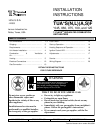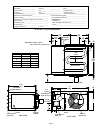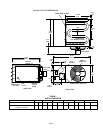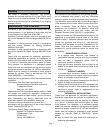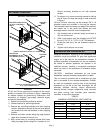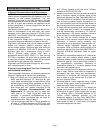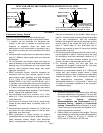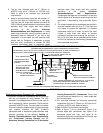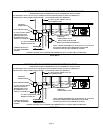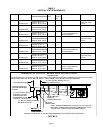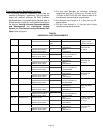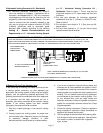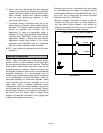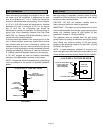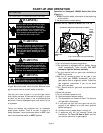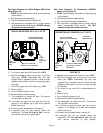
Page 5
A-General Recommendations and Requirements
NOTE - The vent is a passageway, vertical or nearly so,
used to convey flue gases from an appliance, or its vent
connector, to the outside atmosphere. The vent
connector is the pipe or duct that connects a fuel-gas
burning appliance to a vent or chimney. The combustion
air inlet is a pipe that connects the appliance to the
outside atmosphere to convey oxygen from the air to
the appliance burner.
Unit heaters must be vented in compliance with all local
codes or requirements of the local utility, the current
standards of the (American) National Fuel Gas Code,
ANSI Z223.1 or (Canada) CSA-B149 Installation Codes,
and the following instructions.
A vent connection flange and a combustion air pipe
connection flange are attached to the back of the unit.
Single wall vent material shall have all seams and joints
sealed with pressure sensitive aluminum tape or
silicone rubber sealant. Aluminum tape must meet the
provisions of SMACNA AFTS-100-73 Standards. The
aluminum tape has a temperature rating of 400°F
(204°C). Silicone rubber sealant must have a
temperature rating of 482°F (250°C), i.e., Dow Corning
RTV-736 or equivalent. All joints shall be secured with
at least two corrosion resistant screws. All joints must
be checked for gas tightness after installation.
Single wall vent shall not pass through any attic, interior
wall, concealed space, or floor.
B-Vertical Vents Using Metal Vent Pipe- Commercial
and Residential Installations
These separated combustion unit heaters are listed as
Category I appliances for vertical vent installations.
1-These unit heaters are to be vented with NFPA- or
ANSI- approved chimneys, U.L. listed type B-1 gas
vents, single wall metal pipe, or listed chimney lining
system for gas venting where applicable, as well as
the modifications and limitations listed in figure 2.
Seal single wall vent material according to the
section A-General Recommendations and
Requirements. Air inlet pipe may be single wall
metal pipe or U.L. listed single wall metal flex
connector. A concentric vent/adapter/cap kit as
specified in these instructions may be used for
vertical termination. Refer to table 3.
2- The vent connector shall be 3" (76mm) diameter on
45 units, 4" (100mm) diameter on 60/75 units, and
5” (127mm) on 100/125 units. The air inlet pipe shall
be 3” (76mm) diameter on 45 units and 4” (100mm)
diameter on 60/75/100/125 units.
3- Keep the vent and air inlet runs as short as possible
with a minimum number of elbows. Refer to the
(American) National Fuel Gas Code ANSI Z223.1 or
(Canada) CSA-B149 Installation Code for maximum
vent and vent connector lengths. Horizontal run of
the vent connector from the induced draft blower to
the chimney/vent cannot exceed the values in table
2. Single wall vent connector shall not be insulated.
4- If a single wall vent is used in an unheated area it
shall be insulated with a minimum of 1/2" thick foil
faced fiberglass 1-1/2# density insulation. Failure to
do so will result in condensation of flue gases.
5- The unit may be vented vertically as a single
appliance or as a common vent with other gas-fired
appliances. In common venting situations, vent
connectors for other appliances must maintain a 4"
(100mm) vertical separation between the vent
connectors. Refer to common venting tables in the
(American) National Fuel Gas Code ANSI Z223.1 or
(Canada) CSA-B149 Installation Code for proper
vent size.
6- Clearance to combustible material is 6" (152mm) for
single wall vent material except where a listed
clearance thimble is used. Clearance to combustible
material for type B-1 vent or factory-built chimney is
per manufacturer’s instructions. Clearance to
combustible material is 1” on vertical sections of the
concentric vent/adapter/cap kit.
7- The vent connector shall be supported without any
dips or sags. Vertical vents shall be supported in
accordance with their listing and manufacturers’
instructions. All horizontal vent connector runs shall
have a slope up to the vertical vent of at least 1/4"
per foot (1mm per 50mm).
8- All vertical type B-1 vents, single wall vents, or listed
chimney lining system must be terminated with a
listed vent cap or listed roof assembly.
9- The vent must extend at least 3' (1m) above the
highest point where it passes through a roof of a
building and at least 2’ (0.6m) higher than any part
of a building within a horizontal distance of 10'
(3.05m) unless otherwise specified by the
(American) National Fuel Gas Code, ANSI Z223.1
or (Canada) CSA-B149 Installation Codes. The vent
must extend at least 5' (1.6m) above the highest
connected equipment flue collar.
Venting and Combustion Air Inlet



